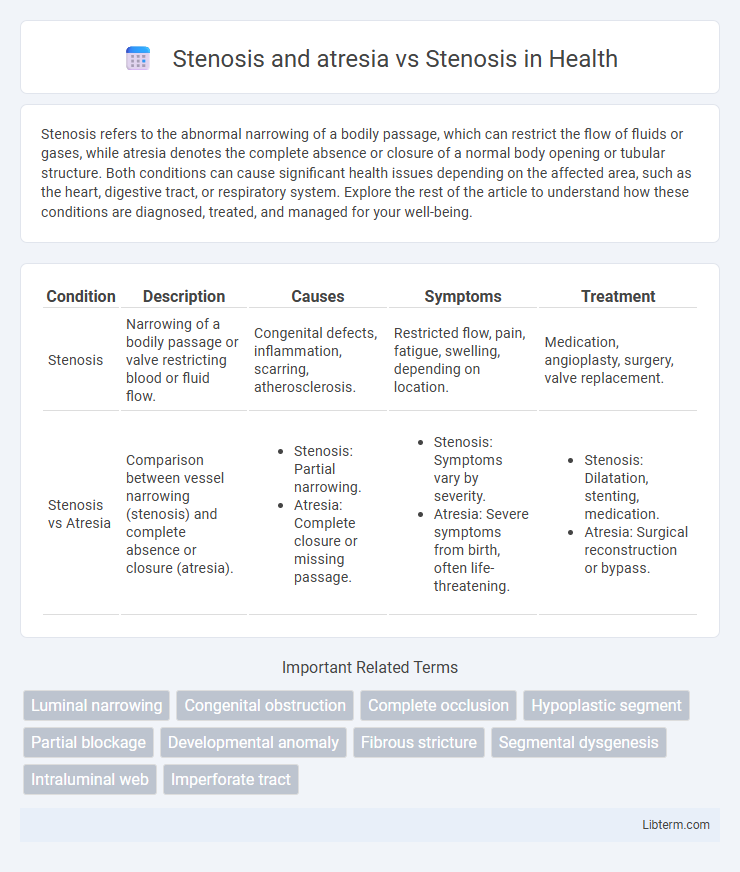Stenosis refers to the abnormal narrowing of a bodily passage, which can restrict the flow of fluids or gases, while atresia denotes the complete absence or closure of a normal body opening or tubular structure. Both conditions can cause significant health issues depending on the affected area, such as the heart, digestive tract, or respiratory system. Explore the rest of the article to understand how these conditions are diagnosed, treated, and managed for your well-being.
Table of Comparison
| Condition | Description | Causes | Symptoms | Treatment |
|---|---|---|---|---|
| Stenosis | Narrowing of a bodily passage or valve restricting blood or fluid flow. | Congenital defects, inflammation, scarring, atherosclerosis. | Restricted flow, pain, fatigue, swelling, depending on location. | Medication, angioplasty, surgery, valve replacement. |
| Stenosis vs Atresia | Comparison between vessel narrowing (stenosis) and complete absence or closure (atresia). |
|
|
|
Understanding Stenosis: Definition and Overview
Stenosis refers to the abnormal narrowing of blood vessels or tubular organs, leading to restricted flow and potential organ dysfunction. Atresia involves a complete absence or closure of a normal bodily passage, resulting in more severe obstruction compared to stenosis. Understanding the differences between stenosis and atresia aids in accurate diagnosis and guides appropriate treatment strategies for conditions such as vascular stenosis or gastrointestinal atresia.
What is Atresia? Key Differences from Stenosis
Atresia is a congenital condition characterized by the complete absence or closure of a normal body orifice or tubular organ, resulting in no passage, whereas stenosis involves the narrowing of a passage that restricts but does not completely block flow. Key differences highlight atresia as a total obstruction from birth, often requiring surgical intervention to create an opening, while stenosis may develop over time due to inflammation, scarring, or congenital malformation and can sometimes be managed with less invasive treatments. Both conditions affect critical structures such as blood vessels, intestines, or airways, but the presence of a complete blockage in atresia distinguishes it fundamentally from the partial constriction seen in stenosis.
Stenosis and Atresia: Etiology and Causes
Stenosis refers to the abnormal narrowing of a bodily passage, often caused by inflammation, congenital defects, or injury, while atresia involves a complete absence or closure of an anatomical passage due to developmental failure during embryogenesis. Common etiologies of stenosis include chronic inflammation from conditions like Crohn's disease or atherosclerosis, whereas atresia is typically linked to genetic mutations or disruptions in fetal development affecting structures such as the esophagus, bile ducts, or heart valves. Both conditions may result in impaired organ function and require diagnostic imaging and intervention based on the severity and location of the obstruction.
Clinical Manifestations of Stenosis
Clinical manifestations of stenosis commonly include symptoms such as localized pain, impaired blood flow, and tissue ischemia, leading to functional deficits in the affected area. In contrast, stenosis combined with atresia presents more severe clinical features due to complete obstruction or absence of the lumen, causing significant symptoms like severe respiratory distress or intestinal obstruction depending on the organ involved. Early diagnosis of stenosis relies on identifying gradual symptom progression, whereas stenosis with atresia often requires urgent intervention due to acute presentation.
Clinical Features of Atresia
Atresia presents with complete obstruction of a hollow organ, leading to severe clinical features such as intense pain, inability to pass contents, and potential systemic symptoms like fever or sepsis in gastrointestinal cases. In contrast, stenosis causes a partial narrowing, resulting in symptoms like intermittent pain, distension, or gradual functional impairment. Clinical features of atresia often necessitate urgent surgical intervention due to risk of tissue necrosis and life-threatening complications.
Sites Commonly Affected by Stenosis vs Atresia
Stenosis commonly affects the vascular system, including coronary arteries, carotid arteries, and peripheral arteries, leading to narrowed blood flow due to plaque buildup or inflammation. Atresia predominantly occurs in congenital abnormalities of hollow organs such as the esophagus, intestines, bile ducts, and heart valves, characterized by complete absence or closure of a lumen. The distinction lies in stenosis involving partial lumen narrowing often from acquired causes, whereas atresia represents a congenital absence or closure of the lumen, frequently impacting critical developmental sites.
Diagnostic Approaches: Stenosis and Atresia
Diagnostic approaches for stenosis and atresia primarily involve advanced imaging techniques such as echocardiography and magnetic resonance imaging (MRI) to assess the severity and anatomical details of the obstruction. Contrast-enhanced computed tomography (CT) scans provide high-resolution visualization crucial for differentiating between stenosis, characterized by narrowing, and atresia, marked by complete absence or closure of a lumen. Cardiac catheterization remains an essential diagnostic tool for measuring pressure gradients and confirming the presence and extent of stenotic or atretic lesions, guiding appropriate therapeutic interventions.
Treatment Options: Stenosis vs Atresia
Treatment options for stenosis typically involve balloon dilation or stent placement to widen the narrowed passage, while atresia requires surgical intervention to create or reconstruct the absent or blocked segment. Endoscopic procedures are common in managing stenosis due to their minimally invasive nature, whereas atresia often necessitates more complex surgeries such as anastomosis or tissue grafting. Postoperative care and monitoring are crucial in both conditions to prevent recurrence and ensure proper function.
Prognosis and Long-term Outcomes
Stenosis and atresia both involve narrowing or complete closure of a bodily passage, but atresia typically results in more severe obstruction, often requiring early surgical intervention to restore function. Prognosis for stenosis alone is generally more favorable, with many patients experiencing improved outcomes following procedures to widen the passageway. Long-term outcomes in atresia cases depend heavily on the timeliness and success of corrective surgery, with potential complications including recurrent obstruction or impaired organ function.
Preventive Measures and Risk Management
Preventive measures for stenosis and atresia emphasize early detection through regular medical screenings and maintaining a healthy lifestyle to reduce risk factors such as inflammation and infection. Risk management involves close monitoring, timely medical intervention, and individualized treatment plans to prevent progression and complications. Proactive management of underlying conditions like congenital defects or chronic diseases significantly improves patient outcomes.
Stenosis and atresia Infographic

 libterm.com
libterm.com